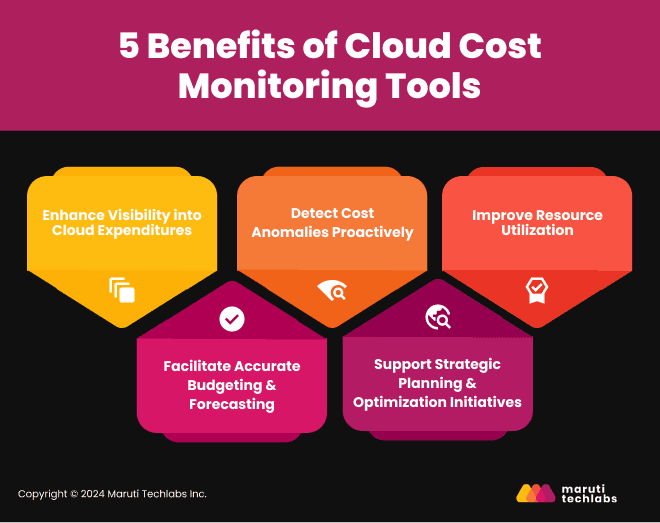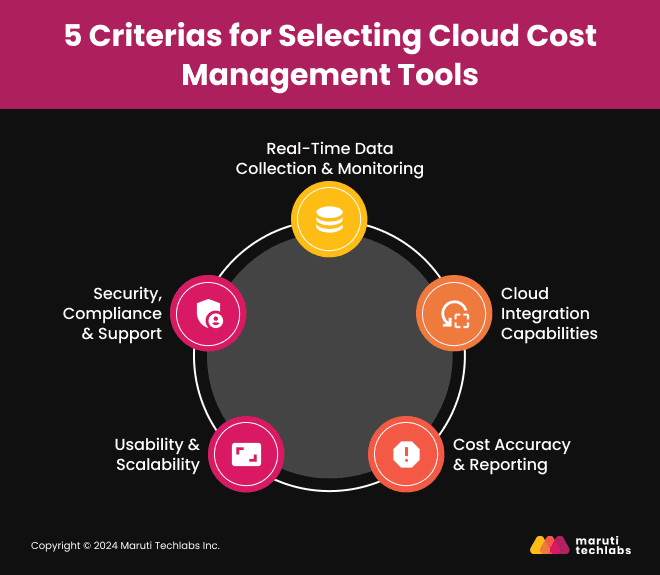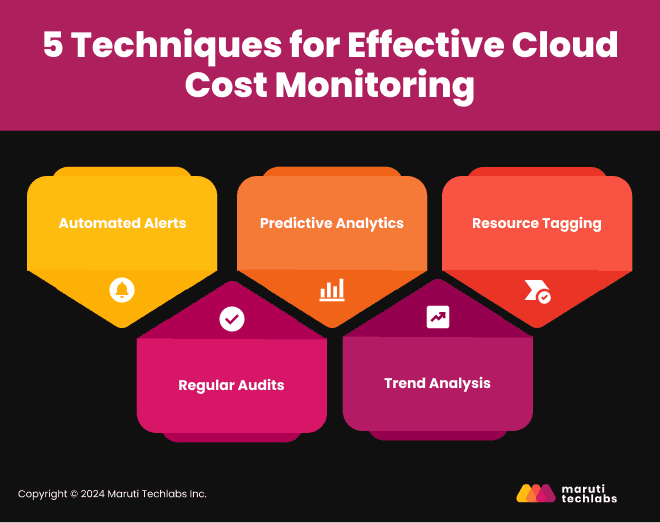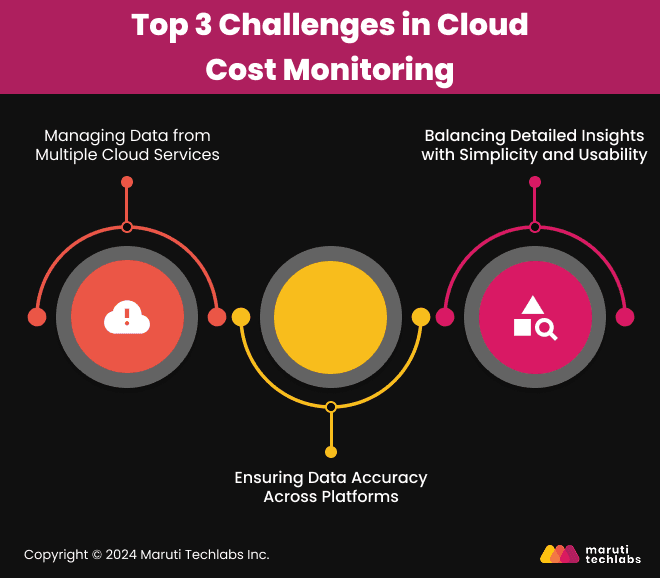

5 Proven Cloud Cost Optimization Software and Strategies in 2025






Cloud services are rapidly expanding, with worldwide end-user spending on public cloud services projected to rise from $595.7 billion in 2024 to $723.4 billion in 2025. As organizations embrace this growth, they face significant challenges, including effectively managing and optimizing their cloud costs.
Cloud cost optimization helps businesses ensure financial efficiency and operational sustainability. By using the right cost optimization software, companies can make informed decisions that lead to substantial savings.
This blog will guide you on using optimization software for cloud cost monitoring and selecting the best cloud cost management tools. It also shares insights on the current top 5 cloud cost management tools and the challenges in cloud cost monitoring.
Cloud cost monitoring is the practice of tracking and analyzing expenses related to cloud services. It provides real-time visibility into cloud usage, helping businesses understand where their money goes. This monitoring is crucial because it allows companies to identify cost spikes, underutilized resources, and potential savings.
Cloud spend management develops entire financial approaches, yet cloud cost monitoring handles expense evaluation and tracking at the detailed level. Because of this distinction, organizations gain quick anomaly detection abilities and optimized spending.
The main goals of cloud cost monitoring are expense observation improvement, budget precision optimization, and prompt anomaly alerting capabilities.
Companies focusing on cloud cost reduction make better spending decisions while minimizing expenses. Cost optimization software enables superior cloud expense control when effectively deployed, improving financial outcomes and operational performance.
Now, let’s understand the benefits of cloud cost monitoring tools.
To help businesses better manage their cloud resources and expenses, cloud cost monitoring tools offer a variety of advantages.

Here are the top 5 benefits of cloud cost monitoring tools:
Cloud cost monitoring tools provide clear insights into spending patterns. By tracking real-time usage, these tools eliminate guesswork and prevent unexpected costs. Companies gain a comprehensive view of their cloud expenditures, make informed decisions, and optimize their budgets effectively.
Precise budgeting is crucial in cloud environments. Cloud cost management solutions enable organizations to forecast expenses accurately based on historical data. This capability helps prevent budget overruns and ensures that resources are allocated efficiently.
These tools are vital in identifying unexpected costs early. By monitoring spending continuously, they send alerts for irregularities. This proactive approach allows companies to address issues before they escalate, ensuring effective cloud cost reduction and maintaining budget adherence.
Cloud cost monitoring tools assist in long-term financial strategies. By analyzing spending trends, organizations can identify areas for optimization and make data-driven decisions. This strategic support leads to improved resource allocation and enhanced business operations.
Effective cloud optimization services help organizations identify underutilized resources. By pinpointing idle assets, companies can reallocate or eliminate unnecessary expenses. The strategy reduces costs and maximizes the value of cloud investments.
Next, we will discuss the key criteria for selecting cloud cost management tools that best meet your organization’s needs.
Given the wide range of options available, companies can make well-informed selections that support their financial objectives by knowing the essential factors.

Some of the selection criteria are as follows:
Timely insights are crucial for effective cloud cost management. Real-time data collecting tools enable enterprises to monitor their expenditures in real time. With this capacity, firms may see cost spikes quickly and take remedial action before costs get out of hand.
Any cost management tool must seamlessly integrate with major cloud providers. Tools that can easily connect with services like AWS, Azure, or Google Cloud provide a unified view of costs across platforms.
This integration simplifies data collection and analysis and makes it easier for organizations to manage their multi-cloud environments effectively. Without this capability, organizations may struggle to achieve comprehensive cloud cost analysis.
Understanding how various projects or departments contribute to cloud spending requires accurate cost allocation. Businesses can break down expenses by service, team, or project using tools with comprehensive reporting options.
This openness is necessary for efficient budgeting and locating opportunities to cut cloud costs. When financial reporting is accurate, organizations may make well-informed decisions about their cloud investments.
Usability and scalability are critical factors when selecting cloud cost management tools. A user-friendly interface allows team members at all levels to navigate the software quickly.
Additionally, scalability ensures that the tool can grow with the business, accommodating increased usage as the cloud needs to expand. This flexibility is essential for long-term success in managing cloud costs.
Data protection is non-negotiable in today’s digital landscape. When selecting a cloud cost management tool, organizations must prioritize security features such as encryption and role-based access control.
Compliance with industry regulations is also essential to avoid potential legal issues. Furthermore, reliable customer support ensures businesses get help when needed which makes software implementation and cost optimization smoother and more effective.
By considering these criteria, organizations can choose the right tools to enhance their cloud expense management efforts and save significant money.
With a clear understanding of what to look for in a cloud cost management tool, let’s explore the top 5 cloud cost management software available to help you optimize your cloud spending effectively.
Selecting the right cloud cost optimization software is crucial for effective financial management. Here are five leading tools that can help organizations optimize their cloud expenses.
CloudZero offers powerful features like real-time cost allocation and anomaly detection, enabling businesses to monitor their cloud expenses effectively. Its unique ability to provide insights into unit economics helps organizations understand the cost of each product or service.
CloudZero’s pricing depends on usage and features. This cost optimization software is particularly beneficial for companies looking to enhance their cloud spend management and improve their overall cloud cost analysis.
Amazon CloudWatch provides comprehensive AWS cost monitoring features, including metrics tracking, log management, and custom dashboards. The free tier includes up to 10 custom metrics and 10 alarms, while paid pricing varies based on usage.
For instance, custom dashboards cost $3 per monthly dashboard, and standard resolution alarms are priced at $0.10 per alarm metric. With its robust capabilities, CloudWatch is essential for businesses seeking effective cloud cost monitoring and multi-cloud cost management tools.
Microsoft native tool, Azure Cost Management, offers functionalities for tracking and analyzing cloud spending across Azure services. It provides detailed reporting features that help organizations identify spending trends and optimize their budgets.
Pricing is typically included with Azure subscriptions, but additional features may incur costs based on usage. Azure Cost Management is unique in that it integrates with Microsoft's other services. This makes it a valuable asset for businesses already using the Microsoft ecosystem for cloud spend management.
Google Cloud Cost Management delivers detailed reporting capabilities and actionable recommendations for optimizing cloud expenses. Its features include budget alerts, cost breakdowns by service, and forecasting tools that help businesses plan for future spending.
Pricing varies depending on usage but is generally competitive within the industry. Google Cloud Cost Management's standout feature is its ability to integrate seamlessly with other Google services.
Flexera One excels in multi-cloud tracking and optimization features where organizations can manage costs efficiently across various cloud platforms. It offers comprehensive visibility into cloud expenditures and provides actionable insights for reducing costs.
Flexera One starts at around $1,200 monthly but can vary depending on the organization's needs. Its unique capability to support multi-cloud cost management tools makes it an excellent choice for businesses operating in diverse cloud environments.
These top five tools provide essential features that empower organizations to optimize their cloud spending effectively. By leveraging these cost-optimization software solutions, companies can achieve significant savings while enhancing their overall cloud financial management strategies.
As we move forward, let's explore the best techniques for effective cloud cost monitoring.
Implementing efficient cloud cost monitoring strategies can significantly improve an organization’s capacity to control costs.

These five strategies might assist businesses in making the most of their cloud expenditures.
Automated alerts for unusual spending patterns are essential for proactive cost management. These notifications help organizations quickly identify and address unexpected spikes in expenses.
By receiving real-time alerts, companies can immediately prevent overspending and ensure better control over their cloud spend management. This feature is a valuable component of any cost optimization software.
Regular cloud audits enable firms to analyze their expenses and find potential savings. Frequent assessments help to identify underutilized resources and avoid wasteful costs.
Implementing a systematic audit approach can help firms improve their cloud cost analysis efforts and maximize the value of their cloud expenditures.
Using predictive analytics, organizations can project future expenditures based on historical data. This method assists companies in creating reasonable spending plans and preparing for future costs. By leveraging data-driven insights, companies can enhance their decision-making to manage and lower cloud costs by aligning expenditures with growth expectations.
Organizations can optimize resource allocation over time using historical data for trend analysis. Businesses can make data-driven judgments about scaling resources up or down as necessary by comprehending consumption trends.
This method guarantees that resources are distributed efficiently and improves total cloud cost monitoring.
Implementing resource tagging techniques into practice improves cost allocation visibility. Organizations may better monitor their spending by assigning resources to projects, teams, or departments.
This technique facilitates the completion of in-depth cloud cost analyses by encouraging ethical use of cloud resources and improving accountability.
These strategies enable businesses to manage their cloud costs efficiently. Companies can considerably save and strengthen their financial position by utilizing these tactics in their cost optimization software.
However, despite these techniques, organizations often face challenges in cloud cost monitoring that can hinder their efforts. Next, we will explore these challenges and solutions to overcoming them effectively.
Some recurring challenges that companies face during cloud cost monitoring are as follows:
Managing data across numerous cloud services is a huge challenge for enterprises. Obtaining a cohesive overall spending picture is challenging because cloud providers have different pricing schemes, services, and invoicing arrangements. This complexity may hamper effective cloud cost monitoring and decision-making, which can cause misunderstandings and inefficiencies.

It is crucial but difficult to provide consistent data accuracy across multiple platforms. Organizations may find it challenging to trust their financial data due to disparities in data reporting that produce false insights. Inaccurate information can ultimately affect the efficacy of cloud spend management strategies and result in bad budgeting decisions.
Another challenge organizations face is presenting complex data in a simple, user-friendly manner. While detailed insights are necessary for practical cloud cost analysis, overly complicated reports can overwhelm users. Striking the right balance between comprehensive data and usability ensures teams can act on insights without confusion.
These difficulties may significantly affect an organization’s capacity to optimize cloud expenses successfully. To overcome these obstacles and improve cloud financial management in general, let’s investigate the more sophisticated capabilities of cloud cost monitoring tools as we proceed.
Advanced features enable businesses to optimize their cloud expenses using technology to increase financial results and streamline operations. Below is a summary of some of these salient characteristics:
AI-driven insights enhance cost-saving strategies by analyzing vast amounts of cloud usage data. These advanced algorithms can identify patterns and predict future costs.
By automating resource management, businesses can ensure they only pay for what they use, significantly improving their cloud cost monitoring efforts. This capability is a key feature of effective cost-optimization software.
Customizable dashboards are essential for tailoring data visualization to meet user needs. These dashboards allow stakeholders to view relevant metrics at a glance. This makes tracking spending and identifying trends easier.
This feature enhances usability and makes it easy for teams to access the details needed for a practical cloud cost analysis. One of the hallmarks of leading cost optimization software is its flexibility.
Integration with other corporate systems provides a comprehensive view of cloud spending. By connecting multi-cloud cost management tools with financial and operational platforms, organizations can analyze costs in the context of overall business performance.
This comprehensive approach improves decision-making and enhances the effectiveness of cloud spend management strategies.
Effective cloud cost monitoring is crucial for organizations that manage expenses in a complex cloud landscape. Techniques such as automated alerts, regular audits, and predictive analytics enhance cloud expense management and help identify potential savings.
Choosing the right cost optimization software is essential for aligning tools with organizational needs and maximizing savings. Advanced features like AI-driven insights and customizable dashboards empower businesses to optimize their cloud spending effectively.
Maruti Techlabs specializes in providing tailored cloud consulting services to help businesses address challenges such as optimizing cloud architecture, enhancing scalability, and managing costs effectively. As cloud adoption grows, organizations increasingly seek robust multi-cloud cost management tools, like those offered by Maruti Techlabs, to implement comprehensive and effective cloud financial strategies.
Get in touch with us today to discover how we can help you optimize your cloud strategy and achieve your business goals.
Companies may compare their cloud spending using cost management systems that provide industry information and comparative analytics. These products often include features that allow businesses to compare their expenses to those of other businesses to identify areas for improvement and ensure competitive pricing in their cloud spending management strategies.
Ineffective cloud cost monitoring can cause overruns and excessive expenditures. Organizations that don't optimize resources or exceed budgets could run into compliance issues. The lack of resources may impact financial health and impede strategic initiatives.
Businesses can improve business operations, increase the accuracy of their budgets, and boost profitability through more astute financial management by making well-informed decisions when they have clear visibility into their cloud spending.
Accomplished vendor management helps organizations reach their goals for optimizing cloud costs. Contract negotiations, pricing model analyses, and SLA compliance verification form part of this endeavor. Through effective vendor management, organizations achieve superior pricing arrangements and optimize their service utilization while maintaining positive provider relationships, which leads to better cloud expense control.
Companies can successfully communicate their cloud cost management plan by highlighting important indicators and insights from data analysis in succinct reports. Regular meetings with stakeholders to discuss outcomes, objectives, and adjustments can encourage transparency and ensure that the company aligns with its financial goals.


